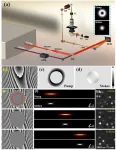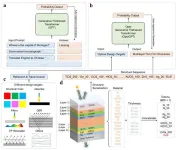(Press-News.org) Nearly 40 million adults in the U.S. have sleep apnea, and more than 30 million of them use a continuous positive airway pressure (CPAP) machine while sleeping. However, the machines tend to be expensive, clunky and uncomfortable — resulting in many users giving up on using them.
High blood pressure is often linked with sleep apnea because the brain works harder to regulate blood flow and breathing during sleep. A recent study at the University of Missouri offers new insight into the underlying mechanisms within the brain contributing to hypertension for those with sleep apnea.
The findings can help pave the way for new drugs that target the brainstem to bring blood pressure back down to normal levels for those with sleep apnea.
The study took place in the lab of David Kline, a professor in Mizzou’s College of Veterinary Medicine and researcher at the Dalton Cardiovascular Research Center.
“When oxygen levels in the blood drop during sleep apnea, the forebrain sends warning signals to the brainstem area that controls heart and lung functions,” Kline said. “By studying these signals, we found that two neurochemicals, oxytocin and corticotropin-releasing hormone (CRH), cause the brainstem to become overactive. Over time, this leads to hypertension.”
Hypertension leads to increased risk of stroke, complications for the metabolism and a variety of other health issues.
“Not only do those with sleep apnea often have high blood pressure, but they also lose a lot of sleep, they have more cognitive and memory issues, and they are more prone to injury at work due to sleepiness,” Kline said.
By being the first to identify the role that oxytocin and CRH play in strengthening and overexciting the pathways and mechanisms involved in sleep apnea, Kline and his fellow researchers hope to pave the way for the design of better therapeutic approaches for humans and animals.
“Our ultimate goal is to eventually help clinicians develop specific drugs to target either these neurochemicals or the proteins they bind to in a way that reduces high blood pressure,” Kline said. “This discovery opens the door for future research to block the pathways these neurochemicals use, ultimately helping to bring blood pressure back to normal levels.”
During the nearly 20 years Kline has researched the mechanisms within the brain responsible for controlling blood pressure and respiration at Mizzou, he has earned more than $10 million in grants and published more than 40 studies in peer-reviewed journals. He is one of the reasons Mizzou — a member of the Association of American Universities and a leading research university — has seen 10 consecutive years of increases in research expenditures.
“I have always been fascinated by the brain and how it contributes to the cardiovascular and respiratory systems of our bodies,” Kline said. “I have a great group of interdisciplinary collaborators here at Mizzou who have helped me out tremendously, and seeing others in my lab make scientific discoveries brings me a lot of joy and excitement.”
The study was led by Procopio Gama de Barcellos Filho, a postdoctoral researcher who works in Kline’s lab.
“What makes Dr. Kline such a great supervisor is he is very encouraging and motivating, and while I have always been interested in neuroscience, he has helped me see the bigger picture in terms of how the brain is tied with the cardiovascular and respiratory systems,” Gama de Barcellos Filho said. “He always wants to hear the thoughts of others in his lab before he makes a final decision, and that is something I will keep in mind if I ever become a principal investigator one day.”
“Oxytocin and corticotropin-releasing hormone exaggerate nucleus tractus solitarii neuronal and synaptic activity following chronic intermittent hypoxia” was published in The Journal of Physiology.
END
How does the brain respond to sleep apnea?
Mizzou researchers pinpoint two neurochemicals that unlock potential targets for new therapies
2024-07-23
ELSE PRESS RELEASES FROM THIS DATE:
NYU Abu Dhabi researchers discover tumor suppressor protein Par-4 triggers unique cell death pathway in cancerous cells
2024-07-23
Abu Dhabi, July 22, 2024: A team of researchers at NYU Abu Dhabi, led by Professor Sehamuddin Galadari, has discovered that the tumor suppressor protein Prostate apoptosis response-4 (Par-4) can cause a unique type of cell death called ferroptosis in human glioblastoma – the most common and aggressive type of brain tumor – while sparing healthy cells. This new understanding has the potential to inform the development of novel treatments for various hard-to-treat cancers and neurodegenerative diseases.
Ferroptosis is triggered by the iron-mediated production of reactive ...
Donald Lloyd-Jones, MD, ScM, chosen to lead BU/NHLBI’s Framingham Heart Study, BU/BMC Department of Medicine Section of Preventive Medicine
2024-07-23
(BOSTON) – Donald M. Lloyd-Jones, MD, ScM, has accepted the position of director of the Framingham Center for Population and Prevention Science, principal investigator of the Framingham Heart Study, and chief of the section of preventive medicine within the department of medicine at the Chobanian & Avedisian School of Medicine and Boston Medical Center, effective January 1, 2025.
Lloyd-Jones is the chair of preventive medicine and Eileen M. Foell Professor of Heart Research and professor of preventive medicine, medicine and pediatrics at Northwestern University. He previously served as senior associate dean for clinical and translational ...
Advanced phase-controlled 3D biochemical imaging
2024-07-23
A new publication from Opto-Electronic Advances; DOI 10.29026/oea.2024.240064, discusses advanced phase-controlled 3D biochemical imaging.
Three-dimensional (3D) imaging provides deep insights into understanding of complex biological and biomedical systems, which offers far more detailed information than traditional 2D methods. A standout in this field is nonlinear optical microscopy, particularly coherent Raman Scattering (CRS) microscopy (e.g., coherent anti-Stokes Raman scattering (CARS) and ...
New junior professorship in Earth System Science at Mainz University sponsored by the Volkswagen Foundation
2024-07-23
Johannes Gutenberg University Mainz (JGU) has established a new junior professorship in the field of Earth System Science, supported by funding provided by the Volkswagen Foundation, Germany's largest private, non-profit organization engaged in the promotion and support of academic research. This Junior Professorship for High-Resolution Sedimentology is part of the JGU Institute of Geosciences and held by Dr. Igor Obreht. He will be creating a unique lab for high-resolution imaging for the analysis of terrestrial and marine sediments that formed thousands to millions of years ago. The resulting data will ...
All-optical ultra-long-distance image acquisition and transmission system
2024-07-23
A new publication from Opto-Electronic Advances; DOI 10.29026/oea.2024.230202 , discusses an all-optical ultra-long-distance image acquisition and transmission system.
With the exponential growth of data globally, the demand for high-speed acquisition and long-distance transmission of multidimensional data is escalating. Online video surveillance in sectors like industrial manufacturing has significantly boosted productivity while mitigating security risks. Real-time global video calls have revolutionized people's daily lives. Existing systems can leverage ...
On-chip spectrometer with high performance, low power-consumption and simple control logic
2024-07-23
A new publication from Opto-Electronic Advances; DOI 10.29026/oea.2024.240099 discusses an on-chip spectrometer with high performance, low power-consumption and simple control logic.
The miniaturized spectrometer has emerged as a powerful tool for analytical applications, particularly due to its promising potential in portable settings. These devices are increasingly integral in various sectors, including health monitoring functions on wearables like smartwatches and food quality inspections through smartphones.
Traditionally, ...
Study uses Game of Thrones to advance understanding of face blindness
2024-07-23
Psychologists have used the hit TV series Game of Thrones to understand how the brain enables us to recognise faces.
Their findings provide new insights into prosopagnosia or face blindness, a condition that impairs facial recognition and affects approximately 1 in 50 people.
The researchers scanned the brains of over 70 study participants as they watched footage from the popular TV series. Half of the participants were familiar with the show’s famously complex lead characters and the other half had never seen the series.
When lead characters appeared on screen, MRI scans showed that in neurotypical ...
OptoGPT: building foundation models for multilayer thin film design
2024-07-23
A new publication from Opto-Electronic Advances; DOI 10.29026/oea.2024.240062, discusses OptoGPT, a new inverse design algorithm.
Optical multilayer thin film structure is one of the most important photonic structures widely used in many applications, including color filters, absorbers, optical cavities or resonators, photovoltaic and radiative cooling, special mirrors for extreme UV lithography and for space telescopes. Designing these structures requires much training and expertise as identifying the best combination of materials and the thickness at ...
Finding a solution for long COVID, one cell type at a time
2024-07-23
COLUMBUS, Ohio – A 2022 study suggesting that blocking a single molecule could protect against severe illness in COVID-19 has led to a $15 million federal grant supporting a comprehensive effort to learn more – with finding a solution to long COVID at the center of the new research.
Since that study’s publication, scientists at The Ohio State University have been exploring how the SARS-CoV-2 virus that causes COVID-19 prompts this human molecule’s destructive activity, and outlined the series of steps needed to fully describe what’s ...
An isolated viral load test may generate false positive results for people using long-acting PrEP
2024-07-23
A single laboratory-based HIV viral load test used by U.S. clinicians who provide people with long-acting, injectable cabotegravir (CAB-LA) HIV pre-exposure prophylaxis (PrEP) did not reliably detect HIV in a multi-country study. In the study, a single positive viral load test was frequently found to be a false positive result. However, a second viral load test with a new blood sample was able to distinguish true positive results from false positive results for all participants whose initial viral load test was positive. The findings were presented at the 2024 International AIDS Conference (AIDS 2024) ...
LAST 30 PRESS RELEASES:
The Ceramic Society of Japan’s Oxoate Ceramics Research Association launches new international book project
Heart-brain connection: international study reveals the role of the vagus nerve in keeping the heart young
Researchers identify Rb1 as a predictive biomarker for a new therapeutic strategy in some breast cancers
Survey reveals ethical gaps slowing AI adoption in pediatric surgery
Stimulant ADHD medications work differently than thought
AI overestimates how smart people are, according to HSE economists
HSE researchers create genome-wide map of quadruplexes
Scientists boost cell "powerhouses" to burn more calories
Automatic label checking: The missing step in making reliable medical AI
Low daily alcohol intake linked to 50% heightened mouth cancer risk in India
American Meteorological Society announces Rick Spinrad as 2026 President-Elect
Biomass-based carbon capture spotlighted in newly released global climate webinar recording
Illuminating invisible nano pollutants: advanced bioimaging tracks the full journey of emerging nanoscale contaminants in living systems
How does age affect recovery from spinal cord injury?
Novel AI tool offers prognosis for patients with head and neck cancer
Fathers’ microplastic exposure tied to their children’s metabolic problems
Research validates laboratory model for studying high-grade serous ovarian cancer
SIR 2026 delivers transformative breakthroughs in minimally invasive medicine to improve patient care
Stem Cell Reports most downloaded papers of 2025 highlight the breadth and impact of stem cell research
Oxford-led study estimates NHS spends around 3% of its primary and secondary care budget on the health impacts of heat and cold in England
A researcher’s long quest leads to a smart composite breakthrough
Urban wild bees act as “microbial sensors” of city health.
New study finds where you live affects recovery after a hip fracture
Forecasting the impact of fully automated vehicle adoption on US road traffic injuries
Alcohol-related hospitalizations from 2016 to 2022
Semaglutide and hospitalizations in patients with obesity and established cardiovascular disease
Researchers ‘listen in’ to embryo-mother interactions during implantation using a culture system replicating the womb lining
How changing your diet could help save the world
How to make AI truly scalable and reliable for real-time traffic assignment?
Beyond fragmented markets: A new framework for efficient and stable ride-pooling
[Press-News.org] How does the brain respond to sleep apnea?Mizzou researchers pinpoint two neurochemicals that unlock potential targets for new therapies






